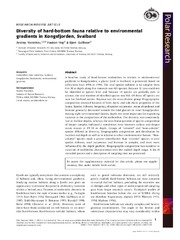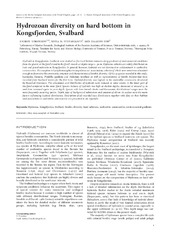| dc.contributor.advisor | Gulliksen, Bjørn | |
| dc.contributor.author | Voronkov, Andrey | |
| dc.date.accessioned | 2014-06-16T10:13:49Z | |
| dc.date.available | 2014-06-16T10:13:49Z | |
| dc.date.issued | 2014-06-04 | |
| dc.description.abstract | Subtidal hard-bottom habitats constitute substantial parts of the Arctic fjord ecosystem. There is a deficiency in complex faunistic surveys of the composition of hard-bottom fauna in the Arctic. The aim of this study was to increase the understanding of how animals are distributed on hard-bottom and their role in the marine ecosystem in the Arctic.
A baseline study of hard-bottom zoobenthos in relation to environmental gradients in Kongsfjorden, a glacial fjord in Svalbard, is presented, based on collections from 1996 to 1998. The inventory resulted in a total of 403 species in 62 samples from 0 to 30 m depth along five transects. Of these, 47 species are new for Svalbard waters.
The diversity generally decreased towards the tidal glaciers in the inner Kongsfjorden. It was consistently low at shallow depths, whereas the non-linear patterns of species composition of deeper samples indicated a presence of different hydrographical conditions between surface and deeper water masses at 15-20 m depth. Among eight environmental factors, depth and distance from the glacier were most important for explaining variance in the composition of the zoobenthos.
Biogeographic composition was sensitive to variation of environmental characteristics over the studied depth range and revealed features of both Arctic and sub-Arctic properties of the fauna. Shifts in climate-related environmental variables are expected to influence the composition of the biota. It will likely result in shifts in ecosystem functioning.
A list of recorded species with distribution and abundance characteristics is given in the Appendix. We contributed to the knowledge of Kongsfjorden ecosystem not only with the biotic data, but also with a description of physical environment at sampling sites.
Seven zoobenthic community types were identified on hard substrata in Kongsfjorden. Method of adequate determination of community types included consideration of species’ potential role in community, accounting for dominant species and similarity in species composition.
Specific approach to the diversity study of hydroids in Kongsfjorden allowed evaluation of the role of a particular taxon in hard-bottom habitats and estimation of importance of abiotic factors in validation of species separation for taxonomic purposes.
The studied habitats and transects should be counted as useful for climate change-related monitoring of diversity on hard-bottom and research on ecosystem functioning. Future studies could reveal new species at these sites related to altered distribution ranges and invasions of species. | en |
| dc.description.doctoraltype | ph.d. | en |
| dc.description.popularabstract | Hardbunnshabitater utgjør en betydelig del av et arktisk fjord-økosystem. Det er utført få komplekse undersøkelser av sammensetning av hardbunnsfauna i Arktis. Målet med dette studiet var å øke forståelsen av hvordan dyr er fordelt på hardbunn og deres rolle det marine økosystemet i Arktis. En grunnlagsundersøkelse av biodiversitet på hardbunn, sett i sammenheng med miljømessige gradienter i Kongsfjorden, en brefjord på Svalbard, presenteres basert på materiale innsamlet ved dykking. Prøvene inneholdt totalt 403 arter, hvorav 47 arter ble registrert på Svalbard for første gang. Variasjoner i diversiteten langs fjordaksen og i forhold til dybde, og sammensetning av dyresamfunnene, beskrives i detalj. De studerte habitater og transekter vil kunne være grunnlag for klimarelatert overvåking av diversitet på hardbunn og forskning på hvordan hardbunnsøkosystemer fungerer. Fremtidige studier vil kunne påvise nye arter på disse lokalitetene relatert til endringer i utbredelse og invasjoner av arter. | en |
| dc.description.sponsorship | The scholarship (Quota Scholarship) for the PhD study was provided by the Research Council of Norway via Norwegian State Educational Loan Fund.
The PhD project was also partly funded by the Research Council of Norway through the Arctic Light and Heat programme and the Eastern Europe programme. Additional funding was provided by the Statoil Arctos Research Programme.
In addition, the project was supported by the Norwegian Polar Institute, the Institute of Marine Research and the doctoral trainee programme of the Arctic Marine Ecosystem Research Network. | en |
| dc.description | Paper 2 of this thesis is not available in Munin: <br/>2. Voronkov A., Hop H., Gulliksen B.: 'Zoobenthic communities on hard-bottom habitats in
Kongsfjorden, Svalbard' (manuscript). | en |
| dc.identifier.isbn | 978-82-8266-082-2 | |
| dc.identifier.uri | https://hdl.handle.net/10037/6381 | |
| dc.identifier.urn | URN:NBN:no-uit_munin_5964 | |
| dc.language.iso | eng | en |
| dc.publisher | UiT The Arctic University of Norway | en |
| dc.publisher | UiT Norges arktiske universitet | en |
| dc.rights.accessRights | openAccess | |
| dc.rights.holder | Copyright 2014 The Author(s) | |
| dc.rights.uri | https://creativecommons.org/licenses/by-nc-sa/3.0 | en_US |
| dc.rights | Attribution-NonCommercial-ShareAlike 3.0 Unported (CC BY-NC-SA 3.0) | en_US |
| dc.subject | VDP::Mathematics and natural science: 400::Zoology and botany: 480::Marine biology: 497 | en |
| dc.subject | Zoobenthos | en |
| dc.subject | Svalbard | en |
| dc.subject | hard substrata | en |
| dc.subject | biodiversity | en |
| dc.subject | environmental gradients | en |
| dc.subject | benthic communities | en |
| dc.subject | Kongsfjorden | en |
| dc.title | Hard-bottom benthic ecosystem in Kongsfjorden, a glacial fjord in the Arctic. | en |
| dc.type | Doctoral thesis | en |
| dc.type | Doktorgradsavhandling | en |


 English
English norsk
norsk


